Day 4 in Oslo was our final day with our Oslo Passes, and we each decided to go to museums of personal interest.
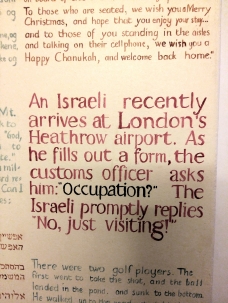 I started my day visiting the Jewish Museum. Jewish history throughout Europe is an area I find fascinating! Each city I go to I visit the Jewish museum, and discover such a varied history and experience each native Jewish people have lived through. Norway is not widely known for its involvement in WWII, however it suffered a huge loss of Jewish citizens during the war; of over 2,000 Jews living in Norway before the war, only 25 survived.
I started my day visiting the Jewish Museum. Jewish history throughout Europe is an area I find fascinating! Each city I go to I visit the Jewish museum, and discover such a varied history and experience each native Jewish people have lived through. Norway is not widely known for its involvement in WWII, however it suffered a huge loss of Jewish citizens during the war; of over 2,000 Jews living in Norway before the war, only 25 survived.
During the war, countless children and families were saved by the Carl Fredriksen Transport Project. A group of rebels saved families by transporting them to Sweden, hidden in trucks, under covers, the children often sedated to keep them calm. Named after the Norwegian King Haakon VII (who’s birth name was Christian Frederik Carl Georg Valdemar Axel) the operation transported over 1,000 refugees to Sweden.
Although a small museum, there is plenty to do; the bathroom is certainly worth a visit, all around the walls are stories or jokes, in Norwegian, English and Hebrew, left as momentos. The building is quite hard to find, hidden away behind gates, you have to be buzzed in, but it houses a fascinating history. The museum was originally a synagogue, however after the war it became a Muslim school, and eventually a Gay Bar!
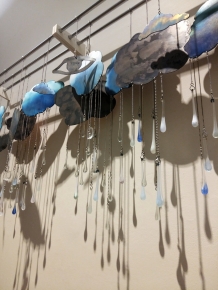 The Museum of Architecture and the Museum of Contemporary Art lie next to one another geographically and are part of the National Galley collections which will soon be housed together in a single building.
The Museum of Architecture and the Museum of Contemporary Art lie next to one another geographically and are part of the National Galley collections which will soon be housed together in a single building.
The Museum of Contemporary art is one of the larger museums in Oslo, and spread over 2 floors. Downstairs was a temporary exhibition by Sidsel Paaske; “On the Verge”. Upstairs houses the permanent exhibitions of Louise Bourgeois and an environmental exhibition spanning most of the upper floor with interactive rooms where you can make model jelly fish, watch films and learn about conservation projects around the world.
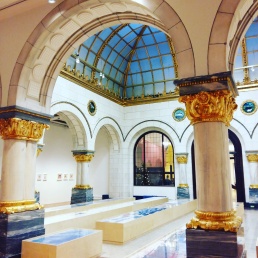 The museum’s interior is beautiful, with golden gilt additions to ceilings and gorgeous arches its architecture itself is worth seeing.
The museum’s interior is beautiful, with golden gilt additions to ceilings and gorgeous arches its architecture itself is worth seeing.
Just across the road from the Museum of Contemporary Art lies The National Museum – Architecture. Housed in the old National Bank Building, and redecorated by architect Sverre Fehn the Architecture Museum contains 1 permanent exhibition and 2 temporary exhibitions at any given time. The permanent exhibition focuses on architecture in Norway and major projects managed by Norwegian architects, such as their Opera House, designed by Snohetta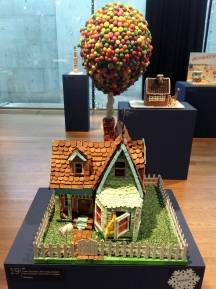 .
.
The smaller exhibition, housed in the vault of the old bank focussed on the bank robberies carried out by Ole Hoiland in 1835, which led to his imprisonment in Akershus Fortress (and his subsequent 11 successful escape attempts).
The final exhibition, “Baking Bad” exhibited works from an annual gingerbread baking competition for school children. They were utterly fabulous!! The photo (left) shows one of the winning entries, a gingerbread model of the house from “Up”. All the entries were inspired by TV or films and ranged from recreations of King Kong hanging from the Empire State Building, to Hagrid’s cabins to Walter White’s infamous meth lab. In the corner was a small station where you could build your own mini sculpture.
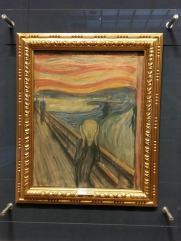 The National Gallery lies about a 15 minute walk from the Architecture and Contemporary Art museums. Admittedly our main purpose of visiting the museum was to see Munch’s Scream, following the disappointing lack of Scream at the Munch Museum. Thankfully it was no Mona Lisa moment and the painting was large, and uncrowded. Our favorite paintings however were by Norwegian painters Christian Krohg and Harald Sohlberg.
The National Gallery lies about a 15 minute walk from the Architecture and Contemporary Art museums. Admittedly our main purpose of visiting the museum was to see Munch’s Scream, following the disappointing lack of Scream at the Munch Museum. Thankfully it was no Mona Lisa moment and the painting was large, and uncrowded. Our favorite paintings however were by Norwegian painters Christian Krohg and Harald Sohlberg.
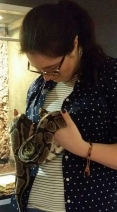 Our final stop for the day was the Reptile Park; definitely one of our favorites. I’ve always loved snakes, as a child most of my birthday parties were animal parties, concluding with a boa constrictor using all the guests stomachs as a transport medium. It was even the highlight of my 18th birthday party, and the snake deciding my little brother looked like a yummy dinner, and beginning to entwine itself around him only made it more entertaining.
Our final stop for the day was the Reptile Park; definitely one of our favorites. I’ve always loved snakes, as a child most of my birthday parties were animal parties, concluding with a boa constrictor using all the guests stomachs as a transport medium. It was even the highlight of my 18th birthday party, and the snake deciding my little brother looked like a yummy dinner, and beginning to entwine itself around him only made it more entertaining. 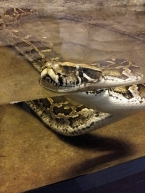 Admittedly the Planet Earth 2 Iguana vs Snake scene made me more wary, but getting to hold a snake was a definite highlight!
Admittedly the Planet Earth 2 Iguana vs Snake scene made me more wary, but getting to hold a snake was a definite highlight!
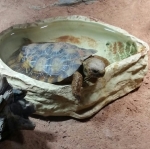 The range of animals at the reptile park was huge! From Marmoset to 10 species of snake, black widow spiders, turtles, alligators and frogs there’
The range of animals at the reptile park was huge! From Marmoset to 10 species of snake, black widow spiders, turtles, alligators and frogs there’
s something for everyone!
If you come at the right time you can see the animals be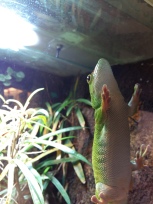 ing fed, and sometimes hold some of them. Even if you arrive too late for this the animals really wake up afterwards! One of the snakes was on a mission to escape, which he kept doing for about half an hour, trying to fit through the small gap in the glass (it was about 1cm wide, no way he could get out).
ing fed, and sometimes hold some of them. Even if you arrive too late for this the animals really wake up afterwards! One of the snakes was on a mission to escape, which he kept doing for about half an hour, trying to fit through the small gap in the glass (it was about 1cm wide, no way he could get out).
The marmosets are very friendly, and will come up to the glass and interact with you, even start talking to you too! They live in an enclosure with a beautiful golden dragon. I may have spent a lot of time befriending the monkeys!
Our evening ended up in Hard Rock Cafe, again. Seriously Oslo, vegetarian food needs to be a thing!
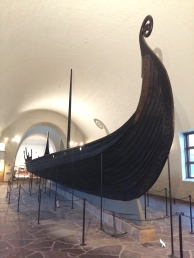 The Viking Ship Museum houses 3 restored Viking Ships, as well as the items found within various Viking Burial sites unearthed by archaeologist Gabriel Gustafson. The ships are beautiful and striking, and housed within what appears to be an old church, any noise echoes throughout the whole building; it creates a peaceful atmosphere.
The Viking Ship Museum houses 3 restored Viking Ships, as well as the items found within various Viking Burial sites unearthed by archaeologist Gabriel Gustafson. The ships are beautiful and striking, and housed within what appears to be an old church, any noise echoes throughout the whole building; it creates a peaceful atmosphere.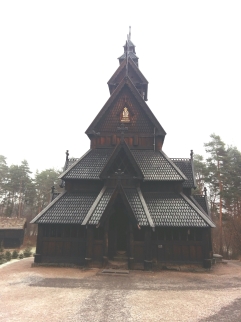 The Folk Museum lies about a 10 minute walk down the road from the Viking Ship Museum. It was by far the largest museum we had visited! The interior museum was split over 2 floors and 2 building, taking visitors on a long journey through a history of crafts, furniture, weapons and Christmas.
The Folk Museum lies about a 10 minute walk down the road from the Viking Ship Museum. It was by far the largest museum we had visited! The interior museum was split over 2 floors and 2 building, taking visitors on a long journey through a history of crafts, furniture, weapons and Christmas.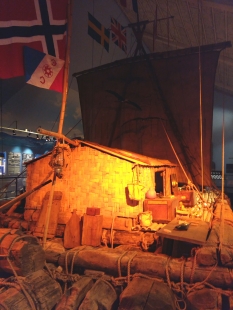
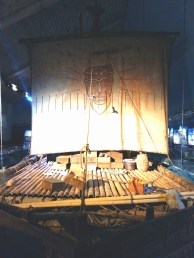 The Kon-Tiki Museum was Emily’s favorite! It followed the 2 expeditions of Norwegian explorer Thor Heyerdahl (1914-2002) and his voyage across the sea on the Kon-Tiki balsalwood raft (pictured right), and his subsequent trips on Ra and Tigris, boats formed from reeds, based on an Egyptian design. For a man with a phobia of open water, he spent an awful lot of time sailing the oceans on vessels scientists promised would not be seaworthy. The museum houses both Kon-Tiki and Tigris, and also has model Easter Island caves, and shows the Oscar winning Kon-Tiki documentary. For a relatively small museum there is plenty to do!
The Kon-Tiki Museum was Emily’s favorite! It followed the 2 expeditions of Norwegian explorer Thor Heyerdahl (1914-2002) and his voyage across the sea on the Kon-Tiki balsalwood raft (pictured right), and his subsequent trips on Ra and Tigris, boats formed from reeds, based on an Egyptian design. For a man with a phobia of open water, he spent an awful lot of time sailing the oceans on vessels scientists promised would not be seaworthy. The museum houses both Kon-Tiki and Tigris, and also has model Easter Island caves, and shows the Oscar winning Kon-Tiki documentary. For a relatively small museum there is plenty to do!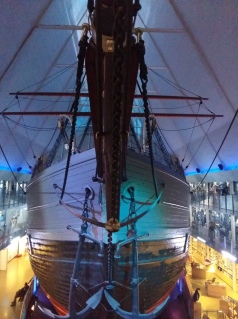 Our final stop for the day was the Fram Polar Expedition Museum. Billed as the ‘Best Museum in Norway’ we left it till last so we could spend as long as we wanted there. Like Moulin Rouge, we discovered it was grossly oversold. I’m sure if you’re doing a PhD in Polar Expeditions it would be highly engrossing, but given neither of has a particularly deep interest the pages and pages of 20pt type wasn’t particularly gripping. Positives now though! The museum is gigantic, and housed across two buildings, the main attraction in each is a huge polar expedition ship. The larger ship, Fram can be boarded, and a small number of the rooms / cabins / galleys explored. Every 20 minutes, from the deck of Fram a Northern Lights show can be watched, projected onto the white roof of the museum, and a sail, fashioned into a screen.
Our final stop for the day was the Fram Polar Expedition Museum. Billed as the ‘Best Museum in Norway’ we left it till last so we could spend as long as we wanted there. Like Moulin Rouge, we discovered it was grossly oversold. I’m sure if you’re doing a PhD in Polar Expeditions it would be highly engrossing, but given neither of has a particularly deep interest the pages and pages of 20pt type wasn’t particularly gripping. Positives now though! The museum is gigantic, and housed across two buildings, the main attraction in each is a huge polar expedition ship. The larger ship, Fram can be boarded, and a small number of the rooms / cabins / galleys explored. Every 20 minutes, from the deck of Fram a Northern Lights show can be watched, projected onto the white roof of the museum, and a sail, fashioned into a screen.

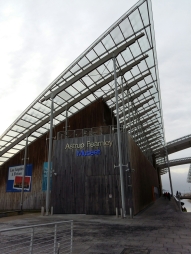


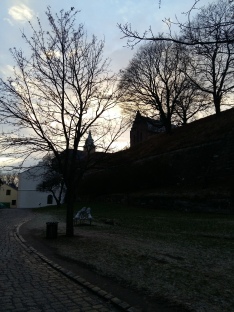 s with all or Norway, it seems, the castle itself was closed for the winter. Ordinarily the interior of the castle, as well as the Mausoleum and Chapel are open to the public, however when we went only the visitors center was available. The visitors center itself was essentially a museum, with 2 rooms focusing on the history of the castle and relations between Norway-Denmark and its battles with surrounding countries, and another room on the castle’s previous function as a prison.
s with all or Norway, it seems, the castle itself was closed for the winter. Ordinarily the interior of the castle, as well as the Mausoleum and Chapel are open to the public, however when we went only the visitors center was available. The visitors center itself was essentially a museum, with 2 rooms focusing on the history of the castle and relations between Norway-Denmark and its battles with surrounding countries, and another room on the castle’s previous function as a prison.